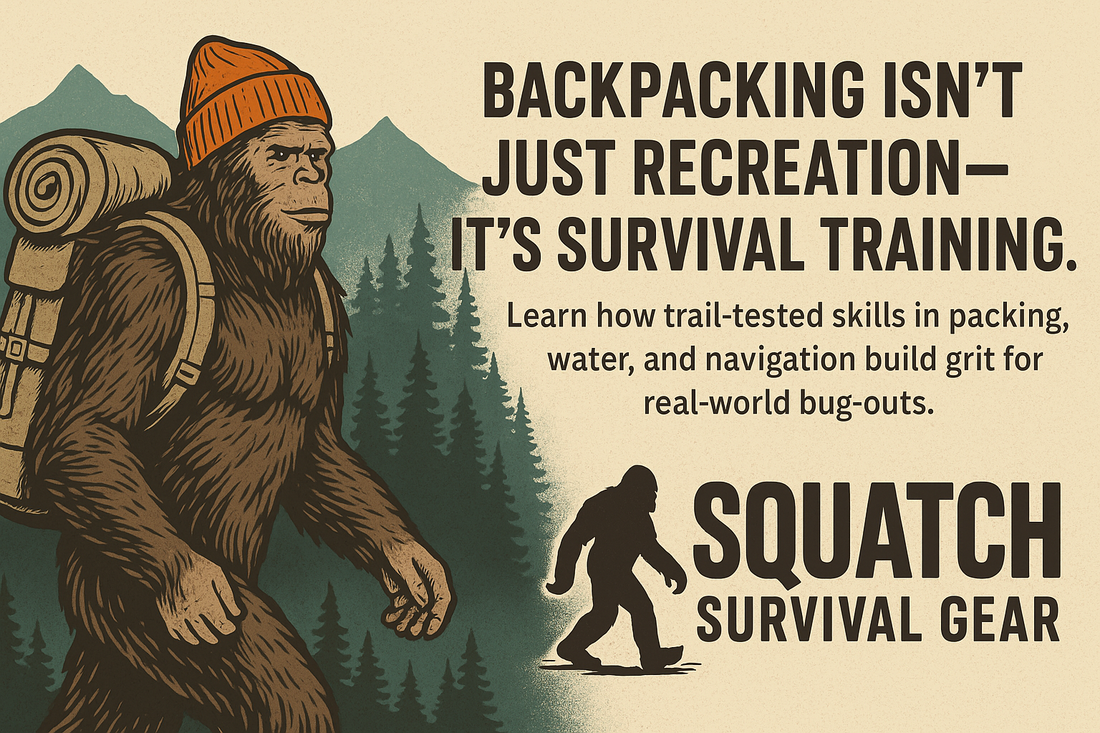Backpacking as Bug-Out Training: Skills That Transfer
At Squatch Survival Gear, our packs aren’t just built — they’re field-tested. Backpacking isn’t only about recreation, it’s practice for real life. Every mile under a loaded pack is a rehearsal for the day you may have to grab your gear and go. The skills you sharpen on the trail — from smart packing to night navigation — are the same skills that will carry you when survival is a must.
Pack Weight & Power Zones
Packing isn’t random. It’s about working with your body’s power zones so you can carry more, go farther, and last longer.
-
Heavy gear (water, ammo, bulk food) belongs centered and tight to your spine, between the shoulder blades and hips.
-
Low-use gear (sleep systems, shelter, spare clothing) rides in the bottom, stable and out of the way.
-
Intermittent gear (rain shell, insulation, headlamp, gloves, water filter) sits at the top, easy to pull once or twice a day without digging.
-
High-demand gear (first aid, maps, snacks, fire-starting tools, comms) belongs in exterior panels or a chest pack for immediate access.
Balance matters. Side-to-side, top-to-bottom — keep your load even. A lopsided pack wrecks your stride, wastes energy, and tears up your shoulders and hips.
“I learned this the hard way on a long ruck when I shoved a water bladder on one side and two radio batteries on the other. Within an hour, my shoulder felt like it was being torn out. Once I repacked and centered the weight, the difference was night and day. Balance isn’t optional — it’s survival.”
Gear tie-in:
-
The Grassman Pack (55L, framed) is built for power-zone loading, with side straps and MOLLE panels to cinch gear tight.
-
The Mothman Pack keeps the load centered and controlled — perfect for fast urban or tactical movement.
-
The Gnome Chest Pack balances your load by shifting survival essentials up front where you can reach them instantly.
Water & Food in the Wild
Water is heavy. It’s also non-negotiable. Backpackers and bug-out movers face the same reality: you’re never carrying all you’ll need, but you can’t afford to run dry.
-
Always carry more than you think you’ll need. Dehydration takes you down faster than cold, hunger, or fatigue.
-
Plan your resupply. Study maps, identify seasonal vs. permanent water sources, and mark refill points before you move.
-
Food discipline. Lightweight, high-calorie foods — nut butters, jerky, freeze-dried meals — keep you fueled without bulk.
Gear tie-in:
-
The Fuelbox Survivor Kit delivers compact calories and power for long hauls.
-
The LifeSaver Liberty purifier means you don’t have to carry gallons — just the knowledge of where to refill.
-
Squatch packs keep food and filters organized, dry, and accessible.
Navigation & Route Planning
In the backcountry, navigation keeps you on trail. In a bug-out, it’s the line between safety and disaster.
-
Traditional tools don’t fail. Maps, compasses, and protractors never need batteries. GPS is a backup, not a crutch.
-
Plan checkpoints. Build rally points, fallback routes, and escape options into your movement.
-
Light discipline. If you can see because of your light, others can see you because of it. Use red filters, shielded beams, or moonlight.
-
Night nav skills. Learn to move under starlight, use terrain features, and read landmarks without glowing like a target.
Gear tie-in:
-
The Gnome Chest Pack keeps nav tools up front where you can check them on the move.
-
Packs like the Mothman and Night Howler give you exterior panels for easy-reach storage.
-
Train with our Land Navigation blog series and turn skills into instinct.
Mental Grit & Adaptability
Every backpacker hits the wall: rain soaks your gear, the trail stretches too long, or your feet are raw. The decision to keep moving is the decision to survive. That decision muscle only gets stronger through reps — and backpacking gives you those reps.
-
Repetition builds endurance. Every trip conditions your body and hardens your mind.
-
Translate to bug-out. When panic sets in during a real disaster, the trail miles you’ve put in become confidence you can draw on.
-
Adapt and overcome. Backpacking forces quick fixes — adjusting straps, patching gear, rerouting when the map changes. That adaptability is survival itself.
Gear tie-in:
-
Squatch packs are built for comfort under load, because fatigue doesn’t just break your body — it breaks your will.
-
Our customers say it best: “This is the most comfortable pack I’ve ever worn.” That’s not luxury — that’s the edge that gets you home.
Wrap-Up
Backpacking isn’t just a hobby. It’s bug-out training in disguise. Every decision, every repacked load, every wet mile prepares you for the day the trail isn’t for fun — it’s for survival.
Equip yourself with American-made, Berry-compliant packs built by hard-working hands here at home. At Squatch Survival Gear, we don’t just make gear — we make gear that gets you further, faster, and home alive.

